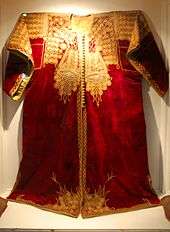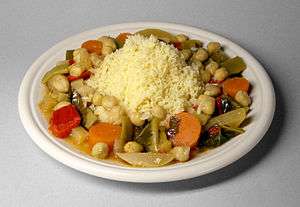Culture of Morocco
The Culture of Morocco has changed throughout Moroccan history, Morocco has hosted many peoples, in addition to the indigenous Berbers,coming from the East Phoenicians, Arabs, South (Sub-Saharan African), and North (Romans, Andalusians both Muslims and Jewish). Morocco also has many dresses like the caftan which is worn worldwide today.
The majority of Morocco's population is Berber and Arab by identity. At least a third of the population speaks the Amazigh language. During the Islamic expansion, some Arabs came to Morocco and settled in the flat regions, such as Tadla and Doukkala. For example, there are groups called Charkawa and Arbawa who settled in Morocco from Arabia. The Charkawa claimed to be descended from Umar ibn Al-Khattab, the second caliph of Islam.


Literature
The history of Moroccan literature started in the early Middle Ages. In the era of the Berber dynasties, coinciding with the flowering of Al-Andalus, there were several important Moroccan writers, especially in the fields of religion.
Ethnic groups and languages

Morocco is considered by some as an Arab-Amazigh country. Others insist on the Amazigh-African identity of Morocco.
Classical Arabic and Tamazight are official language of Morocco.Classical Arabic rather than a mother tongue, and is used in a limited and formal socio-economic and cultural range of activities (like newspapers and official documents), in competition with French.The most common spoken languages of Morocco are Tamazight and Moroccan Arabic.
Linguistically, Amazigh belongs to the Afro-Asiatic group, and has many variants. The three main varieties used in Morocco are Shilha, Central Atlas Tamazight, and Riff (also called Tamazight by its speakers). Collectively, they are known as Shelha in Moroccan Arabic, and as Barbaria in the Classical Arabic used in the Middle East. The terms Barbar and Shelha are considered offensive by most Berber activists, who prefer the term Tamazigh.
Shilha (also known locally as Soussia) is spoken in southwest Morocco, in an area between Sidi Ifni in the south, Agadir in the north, and Marrakesh and the Draa/Sous valleys in the east. Central Atlas Tamazight is spoken in the Middle Atlas, between Taza, Khemisset, Azilal, and Errachidia. Riff is spoken in the Rif area of northern Morocco in towns like Nador, Al Hoceima, Ajdir, Tétouan, Taourirt, and Taza.
Most Amazigh embraced Islam quickly, though their non-Arab ethnic and linguistic distinction has resisted the Arab-Islamic influence. Hundreds of Amazigh (Berber) associations have been created to defend their culture and identity in the last few decades in Morocco and Algeria. Newsstands and bookstores in all the major cities are filled with new Berber publications that provide articles and essays about the Amazigh culture and art. In 1994, the state-owned TV station RTM (now TVM) started broadcasting a daily, 10-minute-long news bulletin in the 3 Berber dialects. Berber activists are repeatedly demanding a 50% share of broadcasting time in standardized Berber (Tamazight) on all state-owned TV channels. There is also a national Tamazight channel in Morocco, called Tamazight TV. It opened in 2010, and broadcasts for over 13 hours a day, with an extended broadcast on weekends.
Traditional clothing

The traditional dress for men and women[1] is called djellaba; a long, loose, hooded garment with full sleeves. The djellaba has a hood that comes to a point called a qob. The qob protects the wearer from the sun or in colder climates, like the mountains, the qob keeps in body heat and protects the face from falling snow. For special occasions, men also wear a red cap called a bernousse, more commonly referred to as a Fez. Women wear kaftans decorated with ornaments. Nearly all men, and most women, wear balgha (بلغه) —- soft leather slippers with no heel, often dyed yellow. Women also wear high-heeled sandals, often with silver or gold tinsel.
The distinction between a djellaba and a kaftan is the hood on the djellaba, while a kaftan does not. Most women’s djellabas are brightly colored and have ornate patterns, stitching, or beading, while men's djellabas are usually plainer and colored neutrally.
Cinema
- 1944: Establishment of the "Moroccan Cinematographic Center" (CCM/the governing body). Studios were open in Rabat.
- 1958: Mohammed Ousfour creates the first Moroccan movie "Le fils maudit"
- 1982: The first national festival of cinema – Rabat.
- 1968: The first Mediterranean Film Festival was held in Tangier. The Mediterranean Film Festival in its new version is held in Tetouan.
- 2001: The first International Film Festival of Marrakech was held in Marrakech.
Movies in Morocco
Some directors have set films in Morocco. In 1952 Orson Welles chose Essaouira as the setting for several scenes in his adaptation of Shakespeare's "Othello", which had won the Grand Prix du Festival International du Film at that year's Cannes Film Festival. In 1955, Alfred Hitchcock directed The Man Who Knew Too Much and in 1962, David Lean shot the Tafas Massacre scene of Lawrence of Arabia in the city of "Ouarzazate", which houses Atlas Studios. Aït Benhaddou has been the setting of many films. The film Hideous Kinky was filmed in Marrakech. .
Domestic architecture

Dar, the name given to one of the most common types of domestic structures in Morocco, is a home found in a medina, or walled urban area of a city. Most Moroccan homes traditionally adhere to the Dar al-Islam, a series of tenets on Islamic domestic life.[2] Dar exteriors are typically devoid of ornamentation and windows, except occasional small openings in secondary quarters, such as stairways and service areas. These piercings provide light and ventilation.[3] Dars are typically composed of thick, high walls that protect inhabitants from thievery, animals, and other such hazards; however, they have a much more symbolic value from an Arabic perspective. In this culture the exterior represents a place of work, while the interior represents a place of refuge.[4] Thus, Moroccan interiors are often very lavish in decoration and craft.
Consistent with most Islamic architecture, dars are based around small open-air patios, surrounded by very tall thick walls, to block direct light and minimize heat.[3] Intermediary triple-arched porticos lead to usually two to four symmetrically located rooms. These rooms have to be long and narrow, creating very vertical spaces, because the regional resources and construction technology typically only allow for joists that are usually less than thirteen feet.[3]
Upon entering a dar, guests move through a zigzagging passageway that hides the central courtyard. The passageway opens to a staircase leading to an upstairs reception area called a dormiria, which often is the most lavish room in the home adorned with decorative tilework, painted furniture, and piles of embroidered pillows and Moroccan rugs. More affluent families also have greenhouses and a second dormiria, accessible from a street-level staircase. Service quarters and stairways were always at the corners of the structures.[3]
Contemporary Art
Contemporary Art in Morocco is still in the making yet with a great potential for growth. Since the 1990-2000s Moroccan cities have welcomed institutions contributing to the diffusion of contemporary art and visual arts: L'appartement 22 and Radioapartment22 in Rabat, the Cinémathèque de Tanger in Tangier, La Source du Lion in Casablanca, Dar Al-Ma’mûn residency and center, the Marrakech Art Fair, and the Marrakech Biennale all in Marrakech.
Local art galleries such as Galerie Villa Delaporte, Atelier 21, Galerie Matisse and Galerie FJ are also platforms showing, to a certain extent, contemporary artwork and contributing to its development.[5]
Global art market also participates in developing and giving visibility to contemporary art in Morocco. International exhibitions such as "Africa Remix" (2004) and "Uneven Geographies" (2010) featured contemporary artists from North Africa, including Moroccan ones. Regional events such as the Dakar Biennale (or Dak'Art – Biennale de l'Art Africain Contemporain), which is a major contemporary African art exhibition and gives greater visibility to artists from this continent.
Moroccan Artists and their Initiatives
Artists born in Morocco or with Moroccan origins include such as Mounir Fatmi. Other artists include Latifa Echackhch, Mohamed El Baz, Bouchra Khalili, Majida Khattari, Mehdi-Georges Lahlou, and the young Younes Baba-Ali.
There are several initiatives from Moroccan artists to help developing a contemporary art market in the country. For example, artists such as Hassan Darsi created La Source du Lion in 1995, an art studio who welcomes artists-in-residence, and Yto Barrada founded the Cinémathèque de Tanger in 2006, which is dedicated to promote Moroccan cinematographic culture. A group of Moroccan artists called Collectif 212 features Moroccan artists such as Amina Benbouchta, Hassan Echair, Jamila Lamrani, Safâa Erruas and Younès Rahmoun. This group is committed to develop more artistic experiences and collaborates with other promising artists such Hicham Benohoud.
There are also promising local artists such as Batoul Shim and Karim Rafi, who both participated in the project "Working for Change", a project trying to act within the fabric of Moroccan society, during the 2011 Venice Biennale.[6]
Cuisine

Moroccan cuisine is home to Berber, and Moorish. It is known for dishes like couscous, tajine, pastilla, and others. Spices such as cinnamon are used in Moroccan cooking.
Sweets like halwa are popular, as well as other sweets. Cuisines from neighbouring countries also influence the country's culinary traditions.
Music
Moroccan music is of Amazigh and Arab origins. Rock-influenced chaabi bands are widespread, as is trance music with historical origins in Muslim music.
Morocco is home to Andalusian classical music that is found throughout North Africa. It probably evolved under the Moors in Cordoba, and the Persian-born musician Ziryab is usually credited with its invention. A genre known as Contemporary Andalusian Music and art is the brainchild of Morisco visual artist/composer/oudist Tarik Banzi, founder of the Al-Andalus Ensemble.
Chaabi ("popular") is a music consisting of numerous varieties which are descended from the multifarious forms of Moroccan folk music. Chaabi was originally performed in markets, but is now found at any celebration or meeting.
Popular Western forms of music are becoming increasingly popular in Morocco, such as fusion, rock, country, metal and, in particular, hip hop.
Morocco participated in the 1980 Eurovision Song Contest, where it finished in the penultimate position.
See also
References
- ↑ https://www.morocco-guide.com/culture/traditional-clothing/
- ↑ Verner, p. 9
- 1 2 3 4 Verner, pp. 41–42
- ↑ Verner, pp. 9–10
- ↑ Bérénice Saliou. Contemporary Art in Morocco. Contemporary Art Magazine, Issue 6
- ↑ Alice Planel. Traveling Back to Ourselves: The Maghreb as an Art Destination, p. 4, higheratlas.org.
Bibliography
- Verner, Corince. (2004). The villas and riads of Morocco. New York: Harry N. Abrams, Inc., Publishers
External links
- Traditional Moroccan music from Morocco's Ministry of Communication